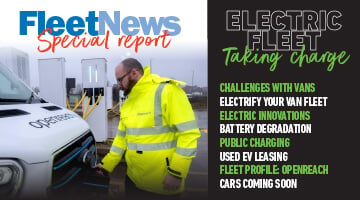Cash-for-car sums add up for fleets
SIR – The front page of last week’s Fleet News carried a report dealing with inefficient cash-for-car-schemes.
The examples given and figures quoted are, I think, misleading in that they fail to take into account the fact that an opt-out driver can claim a tax allowance from the Inland Revenue for any difference between the amount they receive from the company for mileage and the official HM Customs & Excise-approved mileage rates (40p for the first 10,000 mile and 25p thereafter).
Assuming in your example an employee receives £5,000 a year, they are unlikely then to receive more than, say, 15p per mile to cover the cost of business fuel.
If they drive 18,000 business miles, they will receive a tax allowance of 10,000 @ 25p, £2,500, and 8,000 @ 10p, £800, a total allowance of £3,300.
The taxable amount is therefore reduced from £5,000 to £1,700, which at 22% is tax of £374, not £1,100 as stated in your example.
In our company, we have about 100 drivers and operate a very simple cash-for-car scheme in this way. It serves a useful purpose, gives employees an additional option, and administration is easy.
We also insist all opt-out drivers are treated exactly the same as company car drivers when it come to health and safety, driver training etc. The scheme is not seen as a way of lessening our responsibilities.
KEITH POLLARD, Finance and administration director, Agrovista UK
Tax relief on opt-outs
SIR – I refer to the Guest Opinion by Alastair Kendrick in your March 9 edition titled ‘Calculating the true cost of cash opt-out’.
The article includes the statement: ‘Many also neglect to factor in the 40p per mile that employees can claim back for the first 10,000 miles they drive their own cars on company business and the 25p thereafter.’
I believe this to be somewhat flawed in two respects.
Firstly, it appears to assume that the employer will not reimburse the employee in question for the cost of fuel consumed while on business trips. Assuming this isn’t the case, this cost would need to be offset against the relevant AMAP rate when calculating any relief capacity available to the employee.
Secondly, again assuming the employer only reimburses a cash taker for the cost of their business fuel (ie their allowance is paid gross and deemed to cover all other operating expenses) then the employee is only entitled to claim tax relief on the differential between the relevant AMAP rate and the fuel reimbursement amount.
This relief will reference their Marginal Rate of Tax (MRT), whether 40% or 22% to give its true value in net terms.
Perhaps this is best illustrated with reference to a simple example:
Employee X (a 22% tax payer) drives 10,000 business miles in a given tax year in their private vehicle and is reimbursed for fuel at 10ppm by their employer in respect of this travel.
Total AMAP capacity (10,000 x 40p) = £4,000 less
Fuel reimbursed (10,000 x 10p) = (£1,000) equals
Amount on which tax relief is available = £3,000
The critical point is that the employee doesn’t receive £3,000 from Her Majesty’s Revenue & Customs (HMRC) but instead claims tax relief on this amount which in real terms equates to £3,000 x 22% = £660 in this example.
I believe such claims are normally made retrospectively via the annual Self-Assessment Return (SAR) or, if preferred, an adjustment to the employee’s Notice of Coding could be made to deliver this value from the outset with a reconciliation and settlement of subsequent variances being made at the next SAR submission date.
GERRY O’NEILL, Commercial director, Car Benefit Solutions
Square pegs and round holes
SIR – I read with interest the report pertaining to the new ‘easy fuel system’ being introduced by Ford.
I’m afraid the cynic in me says that an awful lot of people must be making a lot of money due to incorrect fuel going into the tank. We do not need hi-tech solutions – the answer is simple. Put square nozzles on petrol vehicles and round nozzles on diesels.
Job done at minimum cost – or am I missing something?
ROGER BLACK, Everest, Potters Bar, Herts
Biofuel threat to rainforest
SIR – Further to your article this week on the subject of biofuels, you may also be aware of recent TV news items that appear to suggest that western society’s increasing demand for eco-friendly fuels is causing countries such as Indonesia to destroy large areas of rainforest in order to plant palm trees to facilitate the production of palm oil, apparently a constituent of biodiesel.
Assuming that to be accurate (and there are several international websites that appear to be supporting and promoting the use of palm oil in vehicle fuels), we are faced with another moral dilemma.
Do we accept the further destruction of the world’s already depleted rainforests in order to satisfy our need for less polluting fuels?
ANDY ROBSON, Robins & Day Leasing, Coventry
Please ensure that e-mails include name, job title, company and company address













Login to comment
Comments
No comments have been made yet.